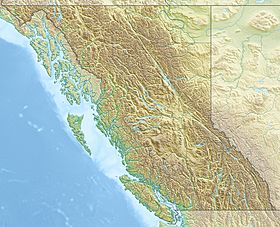Cape Caution facts for kids
Quick facts for kids Cape Caution |
|
|---|---|
| Location | Central Coast, British Columbia |
| Coordinates | 51°09′49″N 127°47′12″W / 51.16361°N 127.78667°W |
| Offshore water bodies | Queen Charlotte Sound Queen Charlotte Strait |
| Length | 2 km (1.2 mi) |
| Width | 2.5 km (1.6 mi) |
Cape Caution is a special piece of land that sticks out into the ocean. It's like a big nose on the Central Coast of British Columbia, Canada. This cape is where two important bodies of water meet: Queen Charlotte Strait and Queen Charlotte Sound. It also marks the border between two areas called the Mount Waddington Regional District and the Central Coast Regional District.
Why it's Called Cape Caution
This cape got its name from a famous British explorer named George Vancouver. He named it in May 1793. He chose "Caution" because the waters around it are often rough and the coastline is very rocky.
Just a year before, in 1792, Vancouver almost lost his ship, the HMS Discovery. It nearly hit a hidden rock about 24 kilometers (15 miles) southeast of the cape. This close call made him realize how dangerous the area could be.
Where is Cape Caution?
Cape Caution is located at the western end of a large piece of land that doesn't have a specific name. The cape itself is about 2 kilometers (1.2 miles) long. At its widest point, it measures about 2.5 kilometers (1.6 miles) across.
On its northwest side, you'll find Blunden Bay. To the southeast, there's Silvester Bay. Even though Cape Caution looks like the furthest point west, the real westernmost tip of this land is actually a place called Neck Ness (51°11′45″N 127°47′44″W / 51.19583°N 127.79556°W).
Protecting the Area
The special nature of Cape Caution and its surroundings is protected. There are two important conservancies (protected areas) here:
- The Ugʷiwa’/Cape Caution Conservancy covers a large area of 25,685 hectares (63,470 acres).
- The Ugʷiwa’/Cape Caution–Blunden Bay Conservancy is smaller, covering 331 hectares (818 acres).
These conservancies help to keep the unique plants, animals, and natural beauty of the headland safe for the future.


